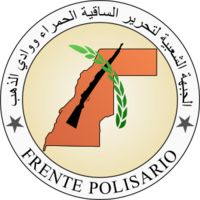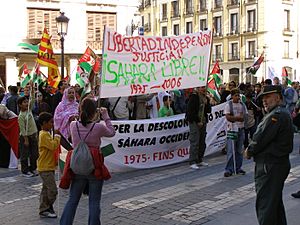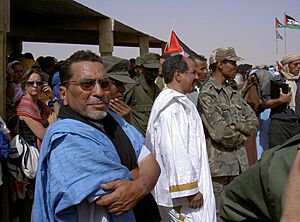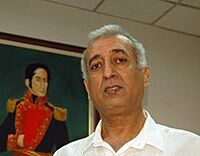Polisario Front facts for kids
Quick facts for kids
|
|
|---|---|
 |
|
| Secretary-General | Brahim Ghali |
| Founder | El-Ouali Mustapha Sayed … and others |
| Founded | May 10, 1973 |
| Preceded by |
|
| Headquarters | Sahrawi refugee camps, Tindouf Province, Algeria |
| Youth wing | Sahrawi Youth Union |
| Women's wing | National Union of Sahrawi Women |
| Trade union affiliation | Sahrawi Trade Union |
| Armed wing | Sahrawi People's Liberation Army |
| Ideology | Sahrawi nationalism Arab nationalism Arab socialism Democratic socialism Social democracy Secularism Historical: Marxism |
| Political position | Left-wing |
| International affiliation | Progressive Alliance Socialist International (consultative) |
| Colors | |
| Anthem | صحراؤنا هي الوطن (lit. Our Sahara is Homeland) |
| Sahrawi National Council |
51 / 51
|
| Pan-African Parliament |
5 / 5
(Sahrawi Republic seats) |
| Party flag | |
 |
|
| Website | |
| (Spanish representation) | |
The Polisario Front is a group that wants Western Sahara to be an independent country. Its full name means "Popular Front for the Liberation of Saguia el-Hamra and Río de Oro." This group uses both peaceful efforts and, at times, armed resistance to achieve its goal. They want the people of Western Sahara, called Sahrawis, to decide their own future.
The Polisario Front started in 1973. At first, they fought against Spain, which used to control Western Sahara. After Spain left in 1975, Mauritania and Morocco took over parts of the territory. The Polisario Front then declared the Sahrawi Arab Democratic Republic (SADR) in 1976. They fought a war against both Mauritania and Morocco. Mauritania gave up its claim in 1979. The fighting with Morocco continued until a ceasefire in 1991. This ceasefire was supposed to lead to a vote (referendum) on independence, but this vote has been delayed many times. In 2020, the Polisario Front said the ceasefire was over and fighting started again.
The United Nations sees the Polisario Front as the official voice for the Sahrawi people. The UN believes the Sahrawis have the right to decide if they want to be an independent country. In areas of Western Sahara controlled by Morocco, the Polisario Front is not allowed. It is also illegal to display their flag there.
Contents
History of the Polisario Front
How the Movement Began
In 1971, some young Sahrawi students in Morocco started a group. They called it "The Embryonic Movement for the Liberation of Saguia el-Hamra and Rio de Oro." They wanted to free their homeland.
They tried to get help from other Arab countries, but didn't get much support. So, the movement moved to Spanish Sahara, which was controlled by Spain, to start a fight for freedom.
The Polisario Front officially formed on May 10, 1973. It was created by these students and some Sahrawi soldiers who had served in the Spanish Army. Their first leader was Brahim Ghali. On May 20, they attacked a Spanish outpost and took weapons. The Polisario Front slowly gained control of large desert areas. By 1975, many Sahrawi soldiers from the Spanish forces joined the Polisario, bringing their weapons and training.
In June 1975, a United Nations team visited Spanish Sahara. They found that most Sahrawi people strongly wanted independence. They also saw the Polisario Front as the strongest political group in the area. With help from Algeria, the Polisario set up its main base in Tindouf.
Spain Leaves Western Sahara
After pressure from Morocco, Spain signed the Madrid Accords. This agreement gave Spanish Sahara to Morocco and Mauritania. In 1976, Morocco took control of the northern part, and Mauritania took the southern part. On February 27, 1976, the Polisario Front declared the Sahrawi Arab Democratic Republic (SADR). They then started a war against both Morocco and Mauritania.
Many Sahrawi people became refugees and fled to camps in Algeria. The Polisario Front helped protect these refugees. Over the next two years, the movement grew a lot. Algeria and Libya provided weapons and money. The Polisario army grew to thousands of fighters. They used jeeps instead of camels and modern assault rifles instead of old muskets. They used quick attacks (guerrilla warfare) against forces in Western Sahara, Morocco, and Mauritania.
Mauritania Withdraws from the Conflict
On August 5, 1979, Mauritania signed a peace treaty. The new Mauritanian government recognized the Sahrawi people's rights to Western Sahara. They gave up their own claims to the land. Mauritania pulled out all its soldiers and later officially recognized the Sahrawi Arab Democratic Republic. This caused a big break in relations between Mauritania and Morocco. Morocco then took over the area of Western Sahara that Mauritania had left.
The Moroccan Wall and the Stalemate
In the mid-1980s, Morocco built a very long sand wall, called the Moroccan Wall. This wall was guarded by soldiers. It enclosed the parts of Western Sahara that were important for their economy. This wall created a stalemate in the war. Neither side could win a clear victory. However, the Polisario Front continued to launch artillery and sniping attacks. The war was very expensive for Morocco. Today, the Polisario controls the part of Western Sahara east of the Moroccan Wall.
Ceasefire and the Referendum Plan
A ceasefire between the Polisario Front and Morocco began on September 6, 1991. The United Nations helped monitor this ceasefire. The agreement included a promise for a vote (referendum) on independence. However, this vote has been delayed because of disagreements over who can vote. Many attempts to restart the process have failed.
In April 2007, Morocco suggested that Western Sahara should have some self-rule, but remain part of Morocco. The Polisario Front, however, still wanted the independence referendum that was agreed upon earlier. They said they would negotiate the status of Moroccans living in the territory if the vote was for independence. Talks were held, but no agreement was reached because both sides would not change their main positions.
The 30-year ceasefire between Morocco and the Polisario Front ended in November 2020. This happened when the Moroccan government tried to open a road in a buffer zone near the border with Mauritania.
Polisario's Beliefs and Goals
The Polisario Front is a group that believes in Sahrawi nationalism. This means they want Western Sahara to be an independent nation for the Sahrawi people. Their main goal is to end Morocco's control over Western Sahara. They also have some ideas from Arab socialism.
The Polisario Front sees itself as a "front" or a broad movement that includes all political views within Sahrawi society. It is not just one political party. They have said that arguments about different political ideas should wait until Western Sahara is independent and democratic. The Polisario Front has stated that once Western Sahara is independent, they will either become a political party in a system with many parties, or they will disband completely. This decision will be made by the Polisario Front's congress after independence.
Views on Armed Conflict
The Polisario Front has always said it is against terrorism and attacks on civilians. They describe their fight as a "clean war of national liberation." Since the ceasefire in 1991, they have said they will try to achieve independence peacefully. However, they also say they have the right to fight again if Morocco does not follow the ceasefire rules, especially if the independence vote is not held.
Relationship with Algeria
Algeria has strongly supported the Polisario Front since 1975. They have provided weapons, training, money, and food for over 30 years. The Polisario Front relies on its bases and refugee camps, which are located in Algeria.
How the Polisario Front is Organized


The Polisario Front is led by a secretary general. The first secretary general was Brahim Ghali. Later, Mohamed Abdelaziz was elected in 1976 and served until he passed away in 2016. The secretary general is chosen by the General Popular Congress (GPC), which meets every four years. This congress includes representatives from the refugee camps, women's groups, youth groups, workers' groups, and the military.
Everyone living in the refugee camps can vote in their local Popular Congresses. They also help with the camp's daily work through small groups. There is no official membership for the Polisario; anyone who helps or lives in the camps is considered a member.
Between the congresses, the main decision-making body is the National Secretariat. It is led by the secretary general and has different committees for things like defense and diplomacy.
Armed Forces
The Polisario Front has an armed wing called the Sahrawi People's Liberation Army (SPLA).
People Who Left the Polisario Front
Since the late 1980s, some members of the Polisario Front have stopped their activities with the group. Many of them returned from the refugee camps in Algeria to Morocco. Some of these former members now support Morocco's claim over Western Sahara.
International Relations

Today, 38 countries around the world recognize the Polisario Front's claim over Western Sahara. Most of this support comes from newly independent African countries. While most Arab countries supported Morocco, Algeria and Libya have given significant support to the Polisario. Many non-aligned countries (countries not allied with major powers) have also supported the Polisario Front.
The Polisario Front's main supporters were originally Algeria and Libya. Cuba also provided some help. Mauritania tries to stay neutral between Morocco and Algeria, even though it officially recognized the SADR in 1984. Algeria's support for the Polisario remains strong.
Besides military and financial aid from Algeria, the Polisario Front also receives humanitarian aid, food, and emergency supplies from international groups like the World Health Organization (WHO) and the United Nations High Commissioner for Refugees (UNHCR). Groups in Spain also provide valuable help.
Western Sahara During the Cold War
The main fighting in Western Sahara happened during the Cold War. However, this conflict was not fully drawn into the rivalry between the United States and the Soviet Union. This was because both superpowers tried to avoid getting too involved, as it would harm their relations with either Morocco or Algeria. Morocco was allied with the US, while Algeria generally sided with the Soviet Union in the 1970s.
The United States said it was neutral, but it militarily supported Morocco against the Polisario during the Cold War. Despite this, the Polisario never received strong support from the Soviet Union or China. Most countries in the Eastern Bloc chose to have trade ties with Morocco and did not recognize the SADR. This meant the Polisario depended mostly on Algeria, Libya, and some African and Latin American countries for political support. Some non-governmental organizations (NGOs) from European countries also helped, usually with humanitarian aid. The ceasefire in 1991 happened around the same time the Cold War ended.
International Recognition of the SADR
A key diplomatic issue between Morocco and the Polisario is whether other countries recognize the SADR as an independent state and the official government of Western Sahara. In 2004, South Africa officially recognized the SADR. Kenya and Uruguay followed in 2005. Some countries have changed their minds, either recognizing or withdrawing recognition of the SADR over time.
See also
 In Spanish: Frente Polisario para niños
In Spanish: Frente Polisario para niños



